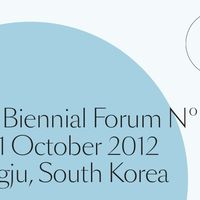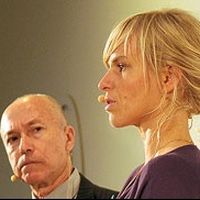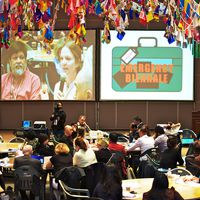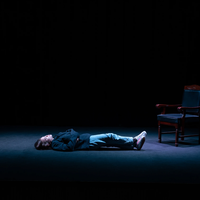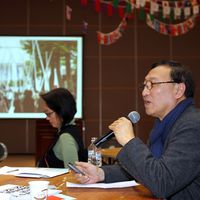World Biennial Forum No.1 | Diary: day 3 and 4
 culture360.org writer Veeranganakumari Solanki shares her thoughts and impressions on the World Biennial Forum No. 1, which took place in Gwangju, South Korea.
culture360.org writer Veeranganakumari Solanki shares her thoughts and impressions on the World Biennial Forum No. 1, which took place in Gwangju, South Korea.Day 3: 29th October 2012
Keynote speech by Professor Nikos Papastergiadis | Case-studies 4, 5, 6 | Speech by René Block | Interactive session | Biennale Representatives Meeting
Ute Meta Bauer began the third day of the Forum mentioning briefly the concerns of the wide margins of diversity within Asia, and the political and cultural focus with the urgency of a Biennale.
There was a common thread of the issue of cosmopolitanism that linked the three keynote speakers over the three days of discussion. Nikos Papastergiadis delivered his keynote speech on Aesthetic Cosmopolitanism (The Widest Possible Frame); through which he revived the terms: Perspective, Imagination, Creation and Cosmos. Addressing these terms in relation to cosmopolitanism and artistic practices, Papastergiadis focused on the idea of the biennale as “a kind of world making activity and part of our cosmopolitan imaginary”, that were an internalisation of and for art. He also addressed a crucial aspect of the behavioural aspect of Biennales branding cities as creative hubs.
The three case-studies presented on Day 3 were:
- Case study 4 | Emergent-Alternative | Emergency Biennale, Kochi-Muziris Biennale, Land Art Mongolia 360°, Tibilisi Triennial, Festival of Images, Bangladesh
- Case study 5 | South-Korea | Gwangju Biennale, Mediacity Seoul, Anyang Public Art Project
- Case study 6 | Asia and its margins | Sharjah Biennale, Istanbul Biennale, Ural Industrial Biennale of Contemporary Art, Meeting Points
Like the first three case studies on Day 2, these three case studies, were also a focus on Asian Biennales, but in very different contexts, which in turn created an awareness of the diversity within the Asian context and the many points of uncertainty within Shifting Gravity.
Case-study 4, was a unique model of Biennales that have faced challenges of governments, organisation, funding, audience and have been beyond the parameters of a Biennale categorisation. The Tibilisi Triennial concentrates on education through art; while the Emergency Biennale and the Festival of Images have gone beyond government systems to integrate public interaction and react to situations of crisis. Land Art Mongolia 360° is a personal investment of time and budget that involves a more humane spirit in relation to the isolation of the art in a landscape. The Kochi-Muziris Biennale was the only Biennale of its kind that was a presentation of a Biennale that is still to take place. The case-study of an emerging Biennale provided some interesting insights into what will develop into India’s first Biennale in December 2012. Artists’ funding and government references were again a common point of reference that by this point in the Forum established this as a need that needs to be addressed internationally.
The prolificacy of Biennales in South Korea cannot be negated. Case-study 5 concentrated on 3 important Biennales in a country that could today be referred to as a centre of this Shifting Gravity. With the Gwangju Biennale as Asia’s first international biennale and Media city Seoul and the Anyang Public Art Project established; this case-study was a reflection of concerns that have matured over a period of time and addressed issues from biennales as alternative art forms and spaces for exhibition to the shifting focus from the West to the East with a reference to co-existence of different disciplines and ideas.
The final case-study group on Asia and its margins, moderated by Hou Hanru addressed the concerns of Asian representation and the multiple diversities of Asian borders. Does a biennale have to be identified with a city with the constant shift of artists around the globe? The aspects of changing geographies and new perspectives of territories are something that is a concern addressed by Asia and its margins.
René Block, the last speaker of the Gwangju session of the World Biennial Forum discussed the history of the Biennial as a location finder and its role in the art scene. An important aspect that he stressed upon, which is also a growing concern in relation the Biennales is the concept of the exhibition as a manifestation of social and cultural exchange.
The interactive session was a wrap up to the wider aspects that were addressed during the forum, with Hou Hanru and Ute Meta Bauer discussing the terrain of legacies that has been created by Biennales across the world. There is a danger of standardisation, but the diversity within which Biennales exist will not allow this.
Biennale Representatives Meeting –
This meeting was attended by representatives from over fifty Biennales with the aim of the necessity of sharing the future. Chaired by Marike van Hal, Yongwoo Lee and Elke aus dem Moore, there were opportunities explored about collaborations and expectations from Biennale colleagues in context to the Biennale being looked at as an organisation. On common ground, the importance of audience interaction and response; educational knowledge, funding and issues of artists’ visas and facilitation were discussed. There was an initiative to create an international platform to support colleagues and to have an official alliance to talk about the future of content and structure. It was finally decided to create a Biennale Association with the reference of the chairpersons who would appoint representatives from regional biennales to create a core committee. This would lead to networking, archiving, sharing information, creating voice collectives, and forming alliances within the historical trajectory of biennales.
Day 4: 30th October 2012
Leeum – Samsung Museum of Art – Anish Kapoor | Seoul Museum of Art – 7th Mediacity Seoul Biennale 2012 | Keynote speech by Professor Chantal Mouffe | SeMA Day dinner
The final day of the Forum was a keynote speech by Chantal Mouffe at the Seoul Museum of Art as a part of SeMA day. This was preceded by an optional tour that included a visit to cultural venues in Seoul. At the Leeum Samsung Museum, Anish Kapoor’s first major solo exhibition in a museum in East Asia; which had his early pigment works to the Cave from his most recent Cor-Ten series. The exhibition occupied the museum in its entirety. This visit was followed by a visit to the Mediacity Seoul Biennale and the final keynote speech delivered by Chantal Mouffe.
Mouffe, also addressed the issues of “Beyond Cosmopolitanism”, while addressing the issues of art and politics and the social resent of political consequences. She spoke about a relevant issue that arose through the Forum of the cosmopolitan nature of artistic practice in Biennales.
In conclusion the Biennales were discussed as creative spaces of diversion of cultures to create encounters.
The first World Biennale Forum ended with a special dinner organised as a part of SeMA day on 30th October on a note of it being the first of more to follow and to create an infrastructure and association of Biennials across the world.
Read World Biennial Forum No. 1 | Diary: day 1 and 2
Similar content
from - to
19 Jun 2023 - 19 Jun 2023
from - to
02 Sep 2014 - 23 Nov 2014

